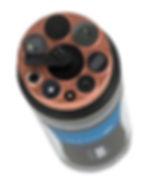What is dissolved oxygen?
Liquid water is a loose matrix of water molecules. If water without oxygen comes into contact with a source of oxygen, such as the atmosphere, then oxygen will slowly move into the gaps in the water-molecule matrix. That oxygen is called dissolved oxygen (DO); it is the same thing as dissolving table salt in water. Oxygen dissolved in water comes from the atmosphere and/or photosynthetic organisms (algae) in the water.
Why would I want to measure dissolved oxygen?
Like humans, fish and other aquatic animals must breathe oxygen to live, and they are adapted to breathe oxygen dissolved in the water instead of oxygen in the atmosphere. Game fish, such as trout, require high DO levels; rough fish, such as carp, can exist at lower DO levels. Fish kills are often caused by low DO levels, which are often triggered, ironically, by decomposition of the algae that had been adding oxygen to the water before death.
DO also influences basic water chemistry. Highly oxygenated waters favor the oxidized form of chemicals; poorly oxygenated waters favor the reduced form of chemicals. For instance, oxygenated waters favor sulfur in the form of sulfate, SO4, while deoxygenated waters favor sulfur in the form of hydrogen sulfide (H2S). Sulfate is a benign substance, but hydrogen sulfide is a poison.
Near-zero DO levels are often found in sediment accumulated at the bottom of a water body. This chemically reducing realm helps lock nutrients and metals into the sediment.
Changes in long-term DO trends can signal the need for more detailed chemical study of the water and its contamination sources.
How is DO measured?
There are two types of sensors commonly used to measure DO. The traditional Clark Cell consists of two electrodes surrounded by a water-based electrolyte solution and covered with an oxygen-permeable membrane. As oxygen crosses the membrane to dissolve in the electrolyte, it is consumed in a chemical reaction which generates a small electrical current between the two electrodes. That current is directly proportional to the amount of oxygen in the water sample. This method is further described in Standard Methods 4500-O G. Eureka no longer offers this type of sensor.
The second type of DO sensor is the optical DO sensor, like Eureka’s HDO, in which a blue light is directed to an oxygen-active compound that has been stabilized in an oxygen-permeable polymer. The blue light causes the oxygen-active compound to fluoresce – i.e. it absorbs energy in the form of blue light and then emits energy as red light. The fluorescence is quenched by oxygen – that is, the emission of red light is reduced if oxygen molecules are present to interfere with the oxygen-active compound. The more oxygen present, the smaller the amount of red light produced.
When the polymer sensing surface is exposed to water, oxygen diffuses into the sensing surface according to the amount (“partial pressure”) of oxygen in the water. Thus, the amount of red light received by the sensor is directly relatable to the amount of oxygen in the water. The red light signal is calibrated to the proper DO units.
Optical DO sensors have become the standard, and are favored over Clark Cells, because they have little calibration drift in the field, are not flow-sensitive (no circulator needed), and do not require difficult membrane changes that annoy Clark sensor users. On July 1, 2007 the EPA approved the ASTM International Method D888-05, Standard Test Methods for Dissolved Oxygen in Water for measuring DO under 40 CFR 136, making optical DO sensors acceptable for use by government agencies.
The amount of oxygen dissolved in, for instance, a lake or river, depends on several variables. The higher the barometric pressure, the more oxygen can dissolve in water. And the higher the water temperature, the less oxygen can dissolve in water.
If the water has absorbed as much oxygen as it can for a particular combination of temperature and barometric pressure, the water is said to be saturated with oxygen. If, on average, no oxygen is moving into the water or out of the water, the oxygen in the water is said to be in equilibrium with the oxygen in the atmosphere.
Dissolved oxygen (DO) is commonly reported in two units. DO concentration is the weight of oxygen dissolved in water and is reported in mg/l or ppm. DO percent saturation is the ratio of oxygen in the water to the maximum amount of oxygen that can dissolve in a water sample under the same conditions and is reported in % saturation.
The older Clark Cell sensor were traditionally calibrated in water-saturated air, but calibration in air-saturated water is growing in favor. The latter is done by shaking a half-liter of water in a one-liter container for one minute, and then waiting one minute for the bubbles to rise to the surface and disappear. The DO sensor is immersed in that water and given time to stabilize. With knowledge of the water temperature and the barometric pressure, the instrument can figure out the DO level in the water because it knows that the water is saturated with oxygen. The instrument sets the DO sensor reading accordingly.
Download .pdf to continue reading here >
Dissolved Oxygen
Range
0 to 50 mg/l
0 to 500% saturation
Accuracy
±0.1 mg/l (0-20 mg/l), ±0.15 mg/l (20-30 mg/l) and ±5% of
reading (30-50 mg/l)
Resolution
0.01 mg/l and 0.1% saturation
Units
mg/l (ppm), % saturation
Calibration
one point in air-saturated water or
two points (air-saturated water and zero)
Maintenance
cleaning and calibration; replace sensor tip (5+ years life)
Sensor Life
6+ years
Sensor Type
optical sensor, lifetime luminescence method
Pressure Limit
200 meters of water























